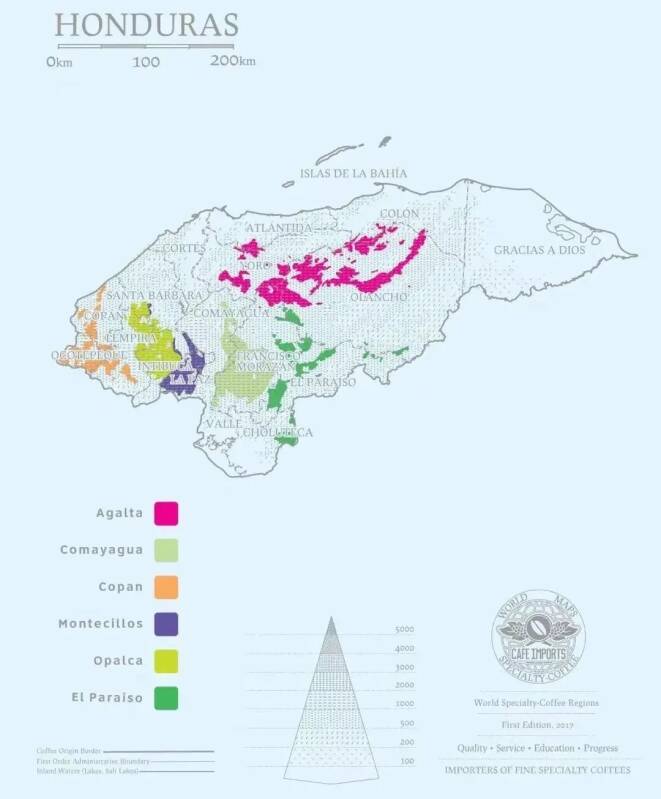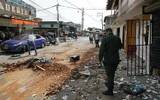What are the characteristics of the Obaraca coffee region in Honduras? What famous manor is there?
Central America is rich in natural resources, the topography is mainly plateaus, mountains and forests, has a volcanic belt of more than 1300 kilometers long, volcanic ash accumulation, fertile soil, and a diverse climate here, Central American coffee has an important position in the global coffee market. There are many well-known coffee-producing countries, such as Honduras, Costa Rica and Panama. Among them, Honduras has a high yield and a high level of coffee at the same time.
Honduras can produce high-quality coffee, thanks to the local terrain and climate. The terrain of Honduras is complex, more than 90% of the country's topography is mountainous and plateau, inland is lava plateau, many mountain valleys, forest area accounts for about half of the national area, the national average elevation of 90-1500 meters.
And the climate of Honduras is diverse, mainly in the tropical climate, the coastal plain belongs to the tropical rain forest climate, the mountain belongs to the subtropical forest climate, the annual average temperature is 23 ℃. June-November is the rainy season, with mild temperature and abundant rainfall, coupled with high-altitude mountain areas and volcanic soil, it is an ideal place for coffee growth.
Coffee was first introduced to Honduras by Spanish businessmen in the 18th century, but at that time Honduran farmers mainly planted bananas and other crops, and coffee was only grown on a small scale. By the end of the 19th century, many coffee plantations were established in Honduras, but on a small scale, and due to the backward transportation construction of the port, it was difficult to export Honduran coffee and had to sell it domestically.

In the 20th century, the coffee industry developed steadily, Honduran roads and ports were built to make exports easier, and the Honduran Coffee Institute (Instituto Hondure ñ o del Cafe, referred to as IHCAFE) was set up to help improve the quality of local coffee. But then Honduras was hit by a hurricane, followed by an outbreak of coffee leaf rust, which hit the industry hard. However, through efforts, the coffee industry has slowly recovered and become an important pillar of the Honduran economy.
The Honduran Coffee Institute (IHCAFE) divides six producing areas into Copan, Opalaca, Montecilos, Conayagua, Agalta Tropical and El paraiso, all of which are more than 1100 meters above sea level.

At present, Montecilos and Conayagua are the more well-known producing areas in the country. In the Honduras Excellence Cup COE in 2024, most of the estates come from these two producing areas, but there are also good indications from other producing areas, such as opalaca in Obalaka.
The opalaca district of Obalaka is located between Santa B á rbara in Santa Barbara province, Intibuc á in Intibuka province and Lempira in Lompilla province, and most of its area is Lempira in the western part of the country. Mount Lasminas, the highest peak in the country, is a volcano at an altitude of 2849 meters, while coffee is grown on a hillside of 1100-1700 meters, with annual rainfall of 1350-1900 mm, with high altitude, volcanic soil and adequate sun and water resources. very suitable for coffee growth.
And make the locally produced coffee with very fine acidity, balanced overall performance, taste with tropical fruits such as grapes, mulberries, etc., with a sour and sweet aftertaste, showing a strong lemon flavor, neutralized with the sweetness of honey and caramel, with obvious fruit flavor
The better-known estate in this area is La Fresa Manor, which is currently managed by Mardo Antonio Vasquez. Mardo has been growing coffee for 21 years. It was very difficult at first, but after continuous farming practice, it gradually improved the quality of coffee and began to participate in the competition in Lompira province to gain competition experience and knowledge. Later, he began to participate in the Excellence Cup COE in Honduras and won the third place in COE in 2023.
Important Notice :
前街咖啡 FrontStreet Coffee has moved to new addredd:
FrontStreet Coffee Address: 315,Donghua East Road,GuangZhou
Tel:020 38364473
- Prev

The civil war in Colombia intensifies! Will face two major anti-government forces
According to local media reports in Colombia, Colombia Defense Minister Ivan Velasquez announced on August 5 that he would restart military operations against the rebels "Colombia National Liberation Army (ELN)." The ceasefire agreement previously implemented by the two sides will not be extended after it expires on August 3. According to "Colombia
- Next

Shocking! A lot of plastic fragments appear in Starbucks drinks!
▲ Click to pay attention| Daily Boutique Coffee Culture Magazine Coffee Workshop Recently, according to the Daily Mail, a netizen posted a video on TikTok, claiming that a large number of plastic fragments appeared in the caramel Frappuccino he purchased at Starbucks. This is the cause of the incident. This woman who doesn't usually visit Starbucks
Related
- Being chased out of the rain in front of Starbucks?! Store: Sheltering from rain under umbrellas poses a safety hazard
- The white moonlight has changed?! Lucky launches "Big Winter Pear American"
- Hand-brewed coffee three-stage method, high-sweet and universal brewing method to share! What does the high sweet water level of hand-brewed coffee mean?
- What is the difference between raw, refined and full espresso coffee? How to extract espresso and taste good?
- A complete list of coffee bean names and their meanings! What is Yejia Shefi coffee? Where is Mantelin coffee?
- What grade does Arida Manor Kaduai coffee beans belong to? What treatment is Arida ASD slow anaerobic sun exposure?
- The milk tea cup becomes smaller?! Overlord Tea Girl launches a new "Return to Yunnan" series
- Accused of selling counterfeit and high-priced coffee beans! Well-known boutique coffee brand "Oukelao" bowed and apologized!
- How to make espresso dumplings? Can I eat coffee and glutinous rice balls together?
- Save the unformed and stagnant powder cakes in one second! What is the problem with stagnant water in the powder bowl of the espresso machine?

